I am still having problems accessing my photographs, so this post will be updated with more detailed pictures when I have solved the problem. I apologise for a post with rather a lot of text which I hope is not as boring as it looks. (14 August 2014: all photos added now and links checked.)
Sitting in Checkendon Church before evensong a few weeks ago my eye was drawn to a sculpted stone angel of downcast solemnity standing all of an arm’s length away in a niche on the north wall. Carved from a finely grained warm-toned stone its perfection is checked only by a single darker patch of stone on a wave of hair as it curves away from the middle of angel’s head. The pose and form of the figure hint – but do not shout – a female angel whose sleek fitting bias cut dress and slight silken belt suggest haute couture as much as anything else from on high. I couldn’t take my eyes off her. Splendid hair cascades in well formed marcel waves in front of powerful wings, while at her feet stand plants (artichoke, bullrushes, sunflower & wheat) of sturdy muscularity, cousins to the 2 dimensional flowers of a Paul Poiret gown or Wiener Werkstatte prints.
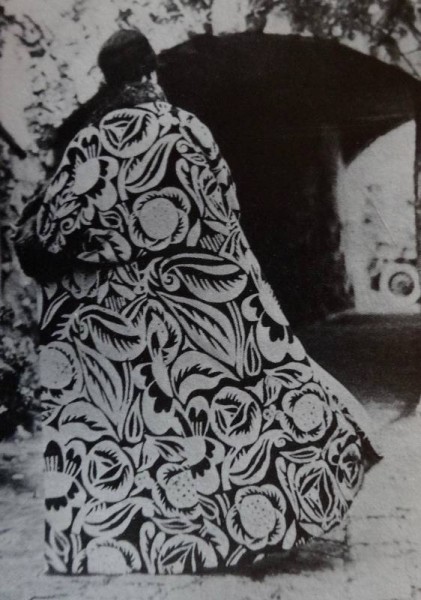
Paul Poiret’s “La Perse” coat using Raoul Dufy’s fabric design (from Alan Powers: Modern Block Printed Textiles, Walker Books 1992)
Young owls, wings outstretched decorate the cushion capitals – that on the left is unfinished, but pitted to indicate cutting lines. In one hand the angel holds a long trumpet, but at rest it’s more like a staff than a musical instrument; in the other hand, a simple jug but whether for water of wine, I couldn’t tell – there seem to be no grapes among the fruit. A bit of a conundrum all told. There is little to be found written about this sculpture, except that it is in Hoptonwood stone and is known as the Rothbarth Memorial. The statue is arresting and, in a quiet way typical of the Arts and Crafts movement, stunning – I love it.
Everybody but me seemed to know that this little gem of sculpture was by Eric Kennington. I had heard mention of him mainly because of the window etched by Lawrence Whistler in memory of Kennington in the same church but I had been more interested in the Whistler bit that the Kennington connection. Now, my return home set me off in search of Eric Kennington and I discovered that not only was he remarkable for having been an official war artist during both world wars but also – perhaps even more remarkably – he had the bad fortune to end up being the most forgotten of all of them, in spite of being well thought of by contemporary artists and writers. (The painter William Nicholson admired and bought a pre-WWI work, The Costermongers with its echoes of Ford Maddox Brown’s painting Work, while the poet Lawrence Binyon in the New Statesman wrote that Mr Kennington “has a genius for reality”.)
Yesterday, as in churches up and down the land, we had special services in our 2 parish churches devoted to considering the start of the First World War and remembering the local families who lost their young men. Local war memorials commemorate a handful of names but as the years have advanced and more research has been done yet more names have come to light. Today, Ipsden and the surrounding hamlets probably have a population of somewhere around 300 (much less pre-1920 when you take into account the houses built since then); 16 men died. North Stoke has a population of just over 200 (again the pre-1920 would have been lower); 9 men died. Of those 25, there were 6 pairs of brothers.
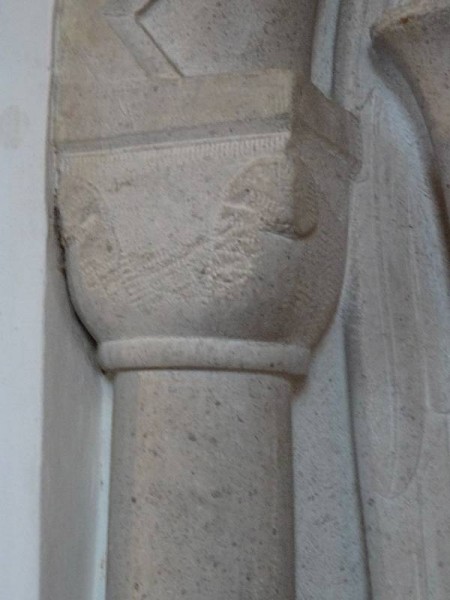
Rothbarth Memorial by Eric Kennington in Checkendon Church: detail showing detail of unfinished owl capital
Eric Kennington lived locally in later life but was born in London and had lived there as a young man. Having a studio in Kensington – it is said round the corner from the local recruiting office – he joined up with the Kensington Battalion (the 13th Battalion, London Regiment, a territorial battalion). To begin with, in 1917, he drew what he saw of the war (soldiers preparing for war, practising with bayonets, bringing in prisoners, trying on gas masks and suffering from the effects of mustard gas) but after being invalided out (with trench fever and an amputated toe) he made a conscious decision not to depict directly the horror of the Front. His most famous work, The Kensingtons at Laventie, was painted in those early months in the battalion and is a group portrait of his comrades. Incredibly it was painted in reverse on glass and was much praised for its technical virtuosity, arresting colour scheme and the quiet heroism of the men. Measuring some 1600mm by 1800mm (5ft+ by just under 6ft) the mind boggles at how he carried such a thing around with him. Do read the blurb about the picture on the IWM’s site as it makes for fascinating reading.
Kennington returned to France as an official war artist just months after being invalided out and once again he worked quickly on whatever subjects came to hand – engineers in action, men suffering from the effect of mustard gas, portraits of men in snatched moments of repose, the changing landscapes. He was voracious in his appetite for subjects and begged to stay on when he was ordered back, saying that he had to ‘learn the war’.
Disliking being ordered about, he fell out with the Ministry of Information and, though still suffering ill, health joined up with the Canadian War Memorial Scheme for whom he went back out to France as a temporary first lieutenant attached to the Canadian Army. Work completed at this time was exhibited in Canada (40 + portraits and a larger painting The Conquerors ) and then in London where one of the last visitors before the exhibition closed was T.E.Lawrence (Lawrence of Arabia) who bought a couple of his drawings of soldiers. Though disenchanted with the British military establishment, Kennington let Lawrence persuade him to go out to the Middle East to draw portraits for Lawrence’s book The Seven Pillars of Wisdom. (Interestingly Lawrence would never let Kennington use the portrait he did of Lawrence himself because he thought it was too revealing.) Kennington’s relationship with Lawrence was close and continued until the latter’s death in 1935 (at the funeral he was a pallbearer). Even after this Kennington and his wife were fierce defenders of his memory and when charges of homosexuality were made against their friend in a book by Richard Aldington, A biographical enquiry : Lawrence of Arabia they and a group of friends worked to try to stop publication. Aldington’s daughter later said that she thought they hounded her father to the point of near breakdown. Privately Kennington was pretty sure that Adlington had been right.
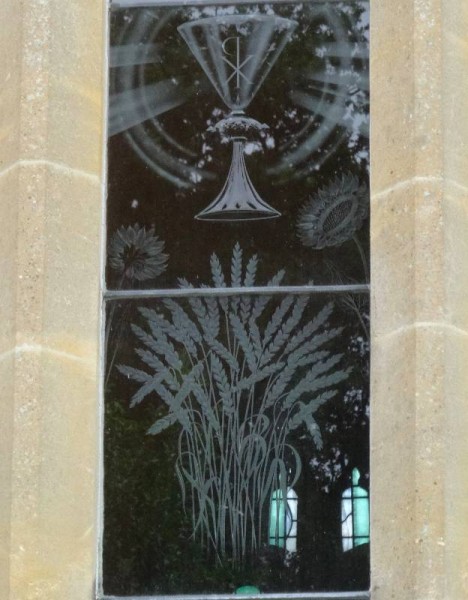
Checkendon church: Laurence Whistler engraved glass window commemorating Eric Kennington: detail showing wheatsheaf, sunflowers and chalice
After WWI Kennington experimented with stone carving. His first public commission still stands in Battersea Park, the war memorial to the 24th Division in Battersea Park (1924 -Robert Graves was the model for one of the 3 soldiers.) Other notable sculpture includes: a bronze bust of Lawrence (in St Paul’s Crypt), another bronze bust of Lawrence , the Soissons Memorial of 1929; 6 allegorical panels and other figures in carved brick on the Shakespeare Memorial Theatre at Stratford and most famous of all the tomb effigy of Lawrence (1937-9) for St Martin’s Wareham.
Sir Kenneth Clark chose Kennington as one of the official war artists for WWII and once more Kennington entered a love/hate relationship with officialdom. In 1939 he went to Plymouth to paint portraits of the sailors who’d distinguished themselves in the Battle of the River Plate – frustration this time came through his perceived under use – he wanted more sitters than he was allocated. Next he threw his energies into the Home Guard and became in charge of 6 countrymen defending an observation post near Homer House, his home in Ipsden. There’s more than a whiff of ‘Dad’s Army’ here. He complained darkly that his men, ‘if not suitably motivated’ would appear for roll call of an evening and then slip off to go poaching, fishing or playing cards in the pub. I must ask around to see if anyone remembers him at this time.
But his reputation for bureaucratic obstreperousness was irrelevant to the public appreciation of his work and when the WAAC (the War Artists’ Advisory Committee) had an exhibition of official war art, his work, especially the portraits, was the most popular. The WAAC wanted him back at work and this time lured him with the bait of working with the one fighting service Kennington had yet to try – the Air Ministry. The Battle of Britain was at its height and portraits of allied air flight crew were required. Kennington was happy to do these (and they provide a unique record, especially because more than 40 of the men he drew were dead by the end of the war). However, when top brass began to outnumber ordinary airmen, Kennington again threatened resignation, which event was only just averted by a visit from the toppest of top brass, the Chief of Air Staff who talked him out of hasty action. (Though this was no doubt flattering, you can’t help but think the Chief of Air Staff had better things to be doing with his time.)
Some critics thought his portraits were of supermen, not mere mortal. The art critic of the Sunday Times thought their “assertiveness almost hurts the eyes”, although he did concede that they looked like men who would win the war, and even went on to suggest the portraits should be dropped as leaflets over enemy country and would be as effective as any bomb.
But would you believe it by 1942, Kennington was missing the army and the Army was equally missing Kennington skills as a portraitist, a painter of heroes, for this time his sitters were to be those credited with bravery in action, like those who came under fire in the retreat to Dunkirk.
1943 saw him back with the Home Guard when he was commissioned to raise their profile which had received a bruising from recent films, most notably, The Life and Death of Colonel Blimp. These paintings appeared in national magazines like The Illustrated London News, The Studio and Country Life to great public effect. It is interesting to note here that Kennington was a great admirer of Oliver Cromwell (1599-1658, Lord Protector of England and signatory of King Charles I’s death warrant) and was among a handful of what we would now call the chattering classes, who considered Cromwell’s New Model Army to be an inspiration for the future development of the Home Guard. Possibly fortunately for Kennington, it was not historic Cromwell but literary John of Gaunt whose words accompanied his 1943 solo show at the Leicester Galleries. Two thirds of his portraits were of the Home Guard and the Sceptred Isle Speech (Richard II Act II, Scene I) hit the right patriotic note.
In later years Kennington settled down to live at Homer House, in Ipsden parish and he specialised in smallish memorials for individual churches (like the memorial in Checkendon Church), although his last known work (completed after his death by his assistant Eric Stanford) was a stone relief panel, The Progress of Science, (1957-8) for the James Watt (South) Building part of Glasgow University. He died in 1960.
I said at the beginning that Kennington was perhaps the least known of the war artists and I am glad that I have discovered that his reputation is undergoing something of a renaissance. Dr Jonathan Black of Kingston University has recorded an online lecture he gave, ‘Portraits like Bombs: Eric Kennington and the Second World War’ which is excellent. (Unfortunately many of the paintings he mentions cannot be shown for copyright reasons, which is a bit irritating.) He shows that Kennington’s special talent lay in depicting the serviceman as an individual, rather than making a painterly lecture on the horrors of war (which he had also done). Now perhaps with the distance of a century for WW1 and 70 years for WW2 it is the faces of those who fought that interest us once more and whereas black and white films and photos taken at the time made the world look very different from today, Kennington’s portraits of ordinary servicemen in the unexpected medium of soft pastels show the humanity of someone we might well think we’ve seen somewhere.
Update 14 August 2014
I begin to think that Kennington can’t possibly have carried a 6′ by 5′ pane of glass around the battlefields of WW1 and I can only claim that the following quote from Kennington on the Imperial War Museum’s website was a bit confusing.
The picture is a complex reverse painting on glass, where exterior layers of paint are applied first, giving the oils a particular clarity. Kennington painted this tribute to his comrades after he was invalided out of the army in 1915. He claimed he had ‘travelled some 500 miles while painting the picture on the back of the glass, dodging round to the front to see all was well.’
I now realise Kennington felt he had travelled some 500 miles dashing back and forth from front to back of the glass rather than travelling 500 miles marching through France. My mistake. Sorry, I must admit I’m rather unwilling to abandon my mental image of Kennington +pane of glass and multiple pots of paints trudging through the mud of northern France – shades of Werner Herzog’s Fitzcarraldo and the hauling of a steamship from one river system to another and going up and down the mountain inbetween.
Anna Sander, Balliol College Archivist, comments below that she checked Ipsden on the 1911 census where a population of 652 was registered for Ipsden Parish (2001: just over 300). This figure caused much amazement at dinner locally the other evening and our ex-church warden * whose family have been here for 100 year + could only think that my husband was right when he pointed out how parish boundaries have changed since then. Yes, more people would have been crammed into farm cottages but surely not 300 more? Curious. This post and its update has exhausted me, so I shall leave it at this for the time being having abandoned a desired clarity of content for the mudiness of how things actually are.
*The father of the ex-church warden had been one of Kennington’s Ipsden Home Guards. No slur of sloping off to poach/fish/going to the pub, etc. should be attached to him – we think.

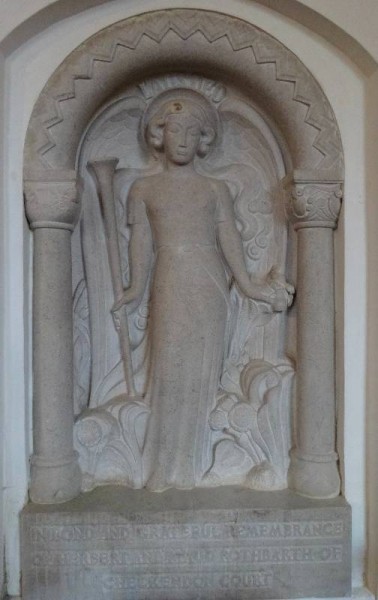
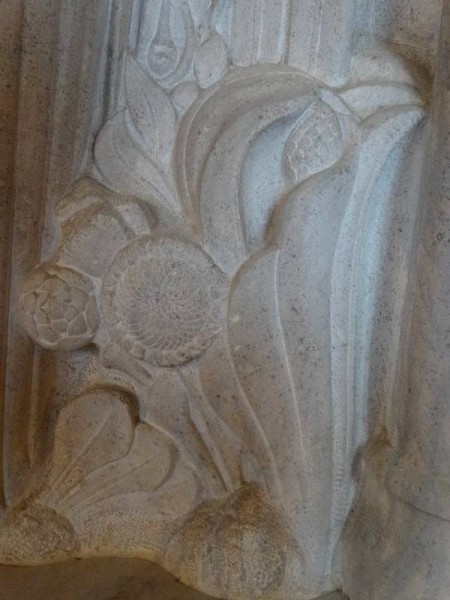
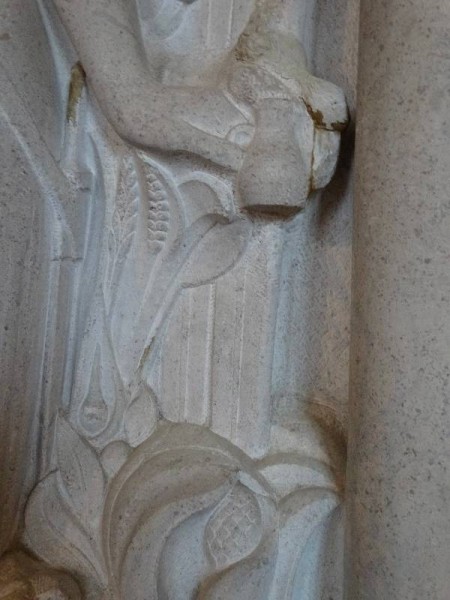
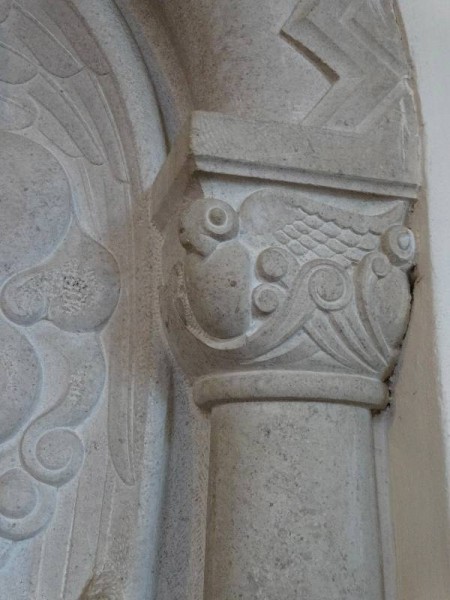
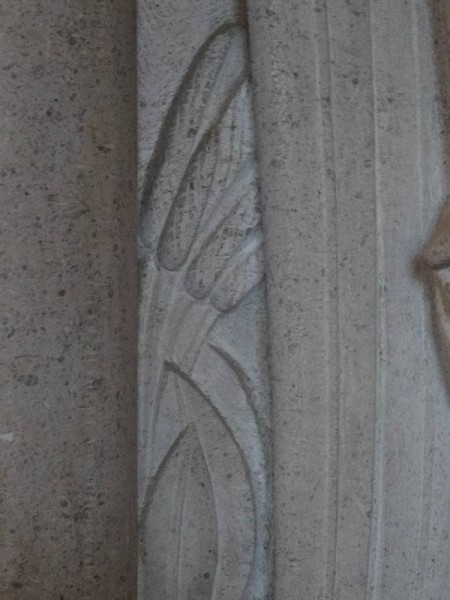
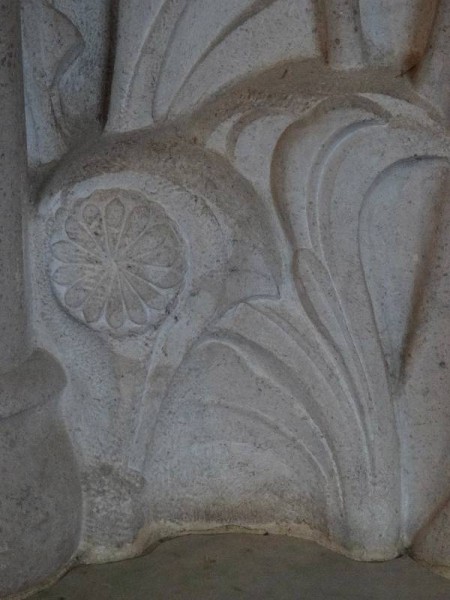
21 Comments
Thank you for introducing me to Kennington. I love the angel, too, and the war picture you sent us to is something I would like to see in person. I have never seen such a large work reverse painted on glass.
Sometimes “mere mortals” are heroes. What they went through……… They deserve to be remembered as heroes.
I can’t get my head round him painting such an enormous picture on glass in a war situation – mind boggling. Why choose glass, or for that matter why choose canvas of those dimensions? Talk about making life difficult for yourself.
A fascinating glimpse into the life of an early war artist. I wondered about the pre-WW1 populations of rural parishes and checked the 1911 census – 652 results for people registered in Ipsden parish and 421 in North Stoke. I didn’t pay to look at the records, so no further details, but that’s quite a lot!
Gosh, thanks Anna. How interesting but how very confusing. It’s true that Ipsden is a series of scattered hamlets and farms and that the cottages of the agricultural workers would have been more densely occupied than many houses are today, but we also can see that quite a bit has been built since WWI. Also there’s further confusion as David says that the civil parish boundaries have changed since then – so we may not be comparing like with like. (Kennington himself lived in Ipsden parish – at Homer – yet is buried in Checkendon.)
According to Wikipedia, the population at 2001 census for Ipsden 332 but it’s not given for N.Stoke which is now part of the civil parish of Crowmarsh Gifford (though I’m sure that previously I found the population of N.Stoke village to be just over 200).
Thank you for your wonderful posts. I enjoy your historical insight , always somthing will peak my interest . I love learning about unexpected things.
Thank you for your kind comment. I’m very pleased you find my random musings of interest – it’s so strange where a bit of research takes you once you get started.
I wonder if he based the angel’s face on someone he knew? A fascinating post. The huge sheet of glass story reminds me of Scot of the Antarctic and the expedition hut; gramophones, art materials etc. dragged for hundreds of miles across the ice- the human spirit never fails to amaze .
I’m beginning to opt for ‘The Kensingtons at Laventie’ being painted in his studio when Kennington was invalided out of the war. The Imperial War Museum’s entry on where it was painted is somewhat obscure as if they weren’t sure either.
You do wonder if the angel was based on someone he knew as portraits were very much his forte but I’ve drawn a blank on this too.
Thank you so much for this post. The painting on glass is one of the most impressive artworks ever, to me. I’ve done two tiny ones and to think of his doing this monumental work in the middle of a war is astounding!
I’m rethinking this as being painted in the studio – see update to post. It does seem an extraordinary medium to use and you wonder what he thought it would add to what is on its own thought provoking subject matter. Having to work out which bits of the painting to paint first and then work backwards – so to speak – and then dash round to the front to see if it looks ok sounds like making painting unnecessarily difficult to me – as you would have first hand experience of yourself!
I visited Checkendon church yesterday mainly to view the lovely Laurence Whistler window memorial to Eric Kennington. The sculpture Rothbarth memorial by Eric Kennington is also beautiful and I wonder what the link is to ‘Rothbarth’?
Also the little pamphlet in the church refers to ‘…a sculpture, unfinished…’ by Eric Kennington. Is this so?
I haven’t discovered the connection to Rothbarth but will ask round again to see if local people know more. The sculpture is unfinished – as you can see in my photos above, one of the owl capitals is fully carved whereas the other is picked out with pitted holes to show the lines to be carved.
Thank you, that was a very prompt reply! I overlooked the photo showing the unfinished capital. Was the memorial carved in situ I wonder?
I will have to go back to the church on a day when the light conditions allow the engraved Whistler window can be better viewed .
If you haven’t seen Kennington’s “The Kensingtons at Laventie, Winter 1914? then you must go to the Imperial War Museum art gallery. The gold highlights on some of the uniform ornaments is outstanding. I had not realised that it was painted in reverse on glass – that might explain why the colours are so vibrant.
Does Eric Kennington have a headstone in the churchyard?
Best wishes
I believe the memorial is to Herbert and Maud Rothbarth who lived in Checkendon Court.
I am not certain but it may be that Maud G Rothbarth was Herbert Rothbarth’s first wife and she died in 1949.
Herbert then married actress Helena Pickard (who was previously married to Sir Cedric Hardwicke).
I have found a newspaper clip here https://www.google.co.uk/search?q=Herbert+Rothbarth&biw=1600&bih=775&tbm=isch&imgil=eIOi0ZsmVVgVLM%253A%253BKwexLwbQVIjJcM%253Bhttp%25253A%25252F%25252Fwww.chrishobbs.com%25252Fpickardhelena.htm&source=iu&pf=m&fir=eIOi0ZsmVVgVLM%253A%252CKwexLwbQVIjJcM%252C_&usg=__KRaDyH-lmkXkAHYseN3P_ybbvr8%3D&ved=0CFcQyjc&ei=knhCVPzoHJHzas_WgJgI#facrc=_&imgdii=_&imgrc=eIOi0ZsmVVgVLM%253A%3BKwexLwbQVIjJcM%3Bhttp%253A%252F%252Fwww.chrishobbs.com%252Fpickard09021960.jpg%3Bhttp%253A%252F%252Fwww.chrishobbs.com%252Fpickardhelena.htm%3B464%3B675
which says Herbert Rothbarth was killed in a car accident near Reading in 1959 (?) a little while after is wife Helena ‘was found dead from barbituric poisoning’.
Sad story if true.
Yes, I’d forgotten this, being I’m afraid more interested in the sculpture as sculpture rather than monument. Eric Kennington is buried in Checkendon churchyard which is sightly odd as he lived at Homer House in the parish of Ipsden (where my husband is vicar). I would love to see ‘The Kensingtons’ as descriptions of it just make the painting more fascinating. If you haven’t already, do click into Dr Jonathan Black’s online talk about him. Thank you for your interesting information.
I think that Kennington painted his glass picture in his studio as this comment says he ‘…painted it after he was invalided out of the army in 1915’. I am sure he would have sketched his friends whilst on duty so that he could later include them in the oil painting.
http://www.iwm.org.uk/collections/item/object/15145
The picture is a complex reverse painting on glass, where exterior layers of paint are applied first, giving the oils a particular clarity. Kennington painted this tribute to his comrades after he was invalided out of the army in 1915. He claimed he had ‘travelled some 500 miles while painting the picture on the back of the glass, dodging round to the front to see all was well.’
Thank you for your comments, Christopher.
Hello Mary
I live near Henley and have love researching connections of the many memorials in our local churches, especially those related to WW1.
I have visited Checkendon church before but my recent visit was prompted by an article I read last week by the journalist Christopher Booker (in the Daily Mail’, which is not a paper I generally read!).
He wrote a rather moving article relating the recent murder of two young British travellers in Thailand with the murder of his sister many years ago also in Thailand.
He then describes how he arranged for Laurence Whistler to create an engraved glass in memory of his sister that was subsequently installed in Salisbury Cathedral.
I think you might lfind the excerpt of the article below interesting and moving:
http://www.dailymail.co.uk/femail/article-2794798/did-sister-foresee-murder-extraordinary-story-haunt-you.html
Excerpt:
Out in Thailand, we had found a splendid ally in the British vice-consul in Bangkok, William Scott.
Hannah Witheridge was found bludgeoned to death with an agricultural hoe last month
Hannah Witheridge was found bludgeoned to death with an agricultural hoe last month
Not only did he keep us briefed on all that was going on but, while I stayed in England to support my parents, he arranged for my sister’s body to be burned by Buddhist monks in the courtyard of a Bangkok monastery — exactly as she would have wished.
He rang me on the morning this was due to take place to say that he would place a bunch of roses on her funeral pyre. Just before the appointed hour, I went up to sit in our village church, having pulled from my shelves the poetry of T. S. Eliot. Opening the book at random, my eyes lighted on the closing words of his poem Little Gidding:
And all shall be well and / All manner of things shall be well / When the tongues of flame are in-folded / Into the crowned knot of fire / And the fire and the rose are one.
There followed an even more remarkable coincidence. We knew that, on her last day in England, she had finally met the great glass engraver Laurence Whistler.
For years, my sister had admired the exquisite draughtsmanship of his engravings, more than the work of any other living artist.
On a sunlit September afternoon, the two of them had sat chatting for two hours in the garden of his old manor house beneath the Wiltshire Downs. They could not have got on better.
A few weeks later, as we left my sister’s funeral in the village in Dorset where we had grown up, another of her close friends said to me, ‘Do you think we could persuade Laurence Whistler to do a memorial window for your sister?’
When we contacted Laurence, his immediate reply was: ‘Ever since I heard that awful news, I have been thinking of exactly that. In fact, I have already begun to sketch out what I have in mind.’
Knowing we had lost two girls to violent deaths, Whistler soon conceived two breathtaking images to commemorate them both. Each showed the Dorset hills our family had looked out on for 30 years. Each was dominated by the vision of a giant rose, radiating light.
Serena had spent two years working for the International Atomic Energy Authority in Vienna. She was an insatiable traveller and had several times driven alone behind the Iron Curtain around Eastern Europe
+7
Serena had spent two years working for the International Atomic Energy Authority in Vienna. She was an insatiable traveller and had several times driven alone behind the Iron Curtain around Eastern Europe
But round them, Laurence had, quite independently, chosen to inscribe those same lines from Little Gidding, ending ‘the fire and the rose are one’.
We obeyed to the letter the instructions my sister had left as to what should be done with her ashes. Half were to be buried next to her sister’s grave in our Dorset churchyard, a quarter were to be scattered round the hills where she had enjoyed riding her horse.
The remainder she wanted to be taken to Austria, to be thrown into the river Danube where it curves round a bend between Vienna and the great abbey of Melk — places she had loved while working in Vienna, which had given her some of the happiest times of her life.
A taxi driver was due to strand trial for Serena’s murder but a week beforehand he died. Christopher still does not know the circumstances of his death
A taxi driver was due to strand trial for Serena’s murder but a week beforehand he died. Christopher still does not know the circumstances of his death
The next year, my mother and I flew out to Vienna to do exactly that, with a group of her friends from that city, on a glorious October day — culminating in a climb to the summit of the Vienna Woods, then at their autumnal best, looking down on the vista far below.
As I threw down the last of her ashes into the bracken, a roe deer jumped up just beneath my feet, taking great, graceful leaps down the steep hill until it was gone. It was like a last farewell.
At the same time, we heard from Bangkok that, a week before the taxi driver was due to stand trial for my sister’s murder, his body had been found in a completely different part of the country, riddled with 17 bullets.
The circumstances of his death remain a mystery. But it was somehow consoling to know that the sad monster responsible for Cly’s death was no longer alive on this Earth.
Later, the plan to put Laurence’s windows into our ancient village church ran into opposition. This left me so perplexed that I turned to an old friend, Sydney Evans, the Dean in charge of Salisbury Cathedral, for advice.
No sooner had I explained the problem than, quite unexpectedly, he said: ‘There is nothing I would like to see more in the cathedral than some glass by Laurence Whistler, an artist I greatly admire.’
So it was that, in 1985, a crowd of more than 100 friends gathered for a service of dedication for those luminous images, which now took the form of two panels softly lit from within. Generally agreed to be among the finest of Whistler’s works, they still draw thousands of admiring visitors a year.
I learned from that experience how important it can be for any family that has to go through such a heart-rending loss to find some similarly healing focus for their grief. Whether it be the creation of a work of art, the setting up of a charitable trust, or working on some other memorial, this can help bring a sense of light and purpose into their lives like nothing else.
All of this is why I have read about this new tragedy in Thailand with a special sense of sympathy for the families left behind.
My sister was far from the first British tourist to that country to be murdered. The Foreign Office tells us 11 others have died like this in the past four years alone.
But I know something of what the bereft families of these latest victims must be going through.
I hope you found that as moving a story as I did and of course it has that connection with the Checkendon window.
Best wishes
Christopher
PS: you will know this of course but the two graves of the Pullen father and son who both served in the RAF in WW1 by the entrance to the church is fairly unusual amongst WW1 casualties. Wife was the Checkendon postmistress.
Thank you Christopher, this is very interesting – connections are utterly fascinating.
Laurence Whistler was at Balliol (from which college library I’ve just retired). He did a lot of celebratory glass (bowls, goblets, not windows) for Oxford colleges and I intend a blog post about this in future.
My husband was previously Vicar of All Saints, Newland in the Forest of Dean and during his time there ran a competition for a new window – Laurence’s son Simon was one of the five shortlisted.
I also know Little Moreton Church in Dorset well and feel that being inside the church looking out through Laurence Whistler’s engraved glass is like being inside one of his engraved bowls – a unique experience.
With best wishes for more happy researching,
Hello Mary,
First a very interesting post, especially as I have just seen my first Kennington church sculpture (and only my second ever – the first being his memorial to the 24th Division in Battersea Park many years ago).
The church sculpture in question is his Baptismal font at St Michael’s Church, Betchworth, Surrey completed by Kennington in 1951.
I am at the start of my research on the font (for a blog post in 2021) but it appears to have been a gift to the church by the parents of James Erskine Cunning, who failed to return from a wartime raid on Essen in August 1941.
I believe that James’ father died before the font could be completed as so he too is commemorated on the item.
For all the sadness connected with the loss of a father and a son, the work is a very uplifing one.
Not only is there a ‘traditional’ image of Christ in the River Jordan, but a mother with her child her arms, St George vanquishing an almost cartoon-like dragon (that you can’t help feel sorry for as his head lies on the ground) and a very jolly airman, dressed in his flying overalls and carrying his parachute.
Interspersed between the figures are four Christian crosses – a traditional Roman cross, a Greek cross, a Cross of St Andrew and a Pattée cross.
Beautiful details such as the baby’s crib, sunflowers, tulips, fruit, corn, mushrooms, fish, birds and even a cat rubbing itself against the mother’s legs all feature.
The wooden font lid – painted in green, reds and black and bearing the Latin inscription ‘Gloria in Excelsis Deo’ – completes the font.
Thanks for your interesting comment Richard.
It’s always good to remind ourselves of artists once held in the highest regard but who are now sadly not so well known.
Best of luck with your future research.
One Trackback
[…] reading my blog on Eric Kennington, and his Checkendon sculpture someone rang me to pass on interesting bits of information – well, rather ancient gossip, I […]